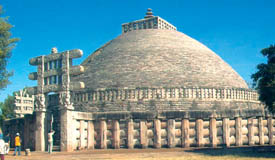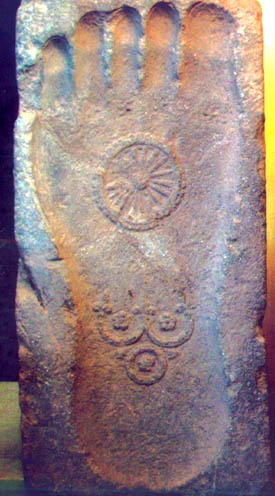|
DAILY NEWS ONLINE |
|
|
|
OTHER EDITIONS |
|
|
|
|
|
|
|
|
|
OTHER LINKS |
|
|
|
|
|
|
 |
|
Vesak 2549 - 2005
|
|
|
The practice of Buddhism today contains a wealth of symbols, images, icons, rites and rituals which have become much studied and admired all over the world. The sheer diversity and richness of various cultural influences as it spread from India to East Asia brought forth its openness, magnanimity and tolerance of cultural assimilation, while maintaining its spiritual focus and values. Although one can sense an entirely different set of practice offered by a Tibetan Buddhist as compared to a Theravadian Buddhist, the underlying principles remain the same.
After the Buddha's Parinirvana, His Relics (or ashes) were distributed to seven kings who built Stupas over them for veneration. The Emperor Asoka was later said to have dug them out, and distributed the ashes over a wider area, and built 84,000 stupas. With the stupas in place, to dedicate veneration, disciples then initiated "Stupa Poojas".
With the proliferation of Buddhist stupas, Stupa Poojas evolved into a ritual act. At first, the object of veneration was the stupa itself (or what it stands for the Buddha). In time, this symbol was supplemented by a more sensitive Buddha image.
The Buddha lived around the sixth century BC, but no Buddhist artifacts are known before the third century BC. The first archaeological evidence, mainly of ornamental stone carvings, comes from the time of the Emperor Asoka (273 - 232 BC), who converted himself to Buddhism and made it a popular religion in India and beyond. Anthropomorphic symbolism appeared from around the 1st century CE with the arts of Mathura and the Greco-Buddhist art of Gandhara where the earliest image of Buddha in human form dates back to the Kushan Dynasty.
In the second century BCE, people started to excavate Buddhist monasteries in rock, creating a large amount of artwork to withstand the ages.The adoption of Buddhism as national religions in China, and subsequently in Korea and Japan, and in South East Asia such as Sri Lanka, Thailand and Burma, cemented the diversity of Buddhism to reflect each of the country's unique national identity.
Dharmachakra
The Eight-Spoke Dharma Wheel or 'Dharmachakra' (Sanskrit) symbolizes the Buddha's turning the Wheel of Truth. It initially only meant royalty (concept of the "Monarch of the Wheel, or Chakravatin), but started to be used in a Buddhist context on the Pillars of Asoka during the 3rd century BC.
The symbolism of the dharma wheel is often given as: (a) its overall shape is that of a circle, representing the perfection of the dharma teaching (b) the hub stands for discipline, which is the essential core of meditation practice (c) the eight spokes represent the Noble Eightfold Path of Buddhism. They are said to have sharp edges to cut through ignorance. (d) the rim, which holds the spokes, refers to mindfulness or Samadhi which holds everything together.
Bodhi-Tree
The Buddha is said to have received his Enlightenment (bodhi) while sitting under a Bo-Tree at the site of the present-day town of Buddha Gaya, India, and the Bo-Tree is therefore sacred to the followers of Buddhism. Tree worship was already part of the existing culture in India, so the development of the Bodhi-Tree as a devotional symbol was a natural one. In the ruins of Anuradhapura, Sri Lanka, is a sacred Bo-Tree that, according to tradition, was planted in the 3rd century BC and grown from a branch of the Tree at Buddha Gaya.
Bo-Tree is the common name for Bodhi-Tree. It is also known as Pipal.
Footprint
The first hint of a human representation in Buddhist symbolism appears with the Buddha Footprint.
|
|
The Footprints of the Buddha are venerated in all Buddhist countries. These highly schematised footprints generally show all the toes to be of equal length, and are incised in stone.
They often bear distinguishing marks - either a Dharma wheel at the centre of the sole, or the 32, 108 or 132 distinctive signs of the Buddha, engraved or painted on the sole and inscribed in a sort of chequerboard pattern.
These imprints are especially venerated in countries such as Sri Lanka, where they are protected in a special structure, sometimes highly elaborate.
Finally, a few images are found chiefly in Tibet on the Thangkas: The prints of the hands and feet of holy personages, generally applied during the ceremony of consecration of the image.
32 signs
Although the Buddha was not represented in human form until around the 1st century CE, the physical characteristics of the Buddha are described in one of the central texts of the traditional Pali canon, the Digha Nikaya, in the discourse titled "Sutra of the Marks" (Lakkhana Sutta).
These characteristics comprise 32 signs or " The 32 signs of a Great Man" (Lakkhana Mahapurisa 32), and were supplemented by another 80 Secondary Characteristics (Anubyanjana).
These traits are said to have defined the appearance of the historical Buddha, Siddhartha Gautama and have been used symbolically in many of his representations.
Stupa
Stupas generally represent the enlightened mind of the Buddha. They were constructed since the early days of Buddhism. There are four types of stupas : (1) Those built over the remains of the Buddha or a disciple (2) Those containing objects used by the Buddha (3) Those marking an important event in the Buddha's life (4) Votive (devotional) Stupas.
The Stupa is said to symbolize the five elements and their relationship to enlightened mind.
These are the essential attributes of a fully realised human being: the base of the stupa signifies earth and equanimity; the dome, water and indestructibility; the spire, fire and compassion; above the spire, wind and all-accomplishing action; and at the very top, the jewel represents space and all-pervading awareness. The stupa is a sacred arrangement, containing all of these enlightened qualities.
Flag
A much more recent symbol is the Buddhist flag. It was designed in 1880 by Colonel Henry Steele Olcott, an American journalist.
It was first hoisted in 1885 in Sri Lanka and is a symbol of faith and peace, and is now used throughout the world to represent Buddhism. The six colours of the flag represent the colours of the aura that emanated from the body of the Buddha when He attained Enlightenment.
|
|
|
|






